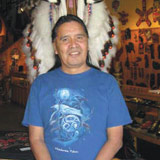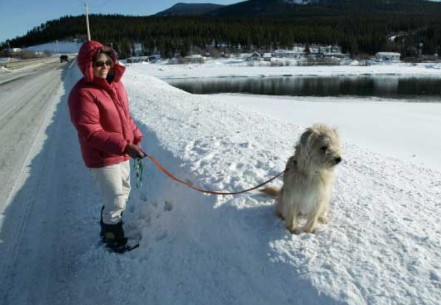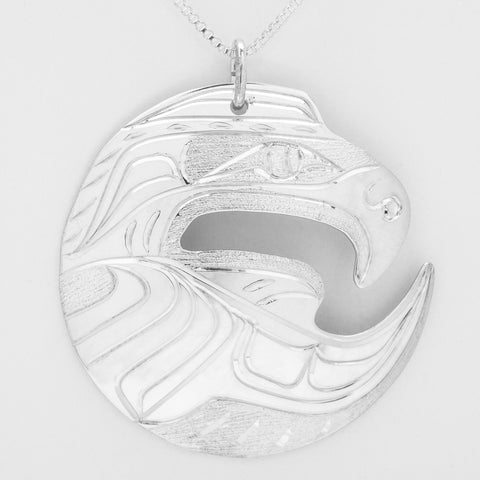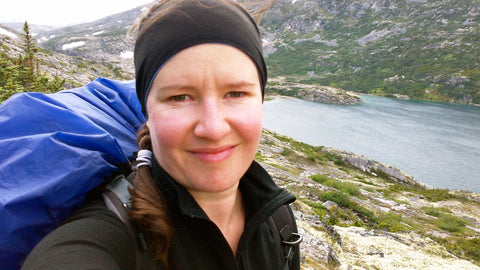


Halin de Repentigny - Art of the Wilderness

Yukon artist Halin de Repentigny was born in Montreal, Quebec in 1959. As a boy he demonstrated an interest and natural ability as an artist. He started painting with watercolours when he was six and began using oils by the age of 10. Exposure to the styles and techniques of French-Canadian Impressionists Maurice Lebon and Marcel Farreau made a significant impact on Halin. He abandoned a conventional education, and without any formal art training, merged his extraordinary skills of observation with canvas and oils, and began to record the world around him.
Halin’s arrival in the Yukon meant a new start - especially in his artistic career. Having already gained notoriety in Quebec, he was unknown in the Yukon. Closely following his arrival to Dawson City, he took up position on the corner of 2nd Ave and King St where he whipped off unerring caricatures for pocket money. By the next summer his murals were showing up to grace the sides of the false-fronted buildings. Scenes of historic Dawson City promptly became the subject of the many paintings created at remarkable speed by de Repentigny, as well as the colourful residents of Halin’s new home. There are many private collections of his work amassed particularly during this time. Soon he began to explore life outside of civilization, the Yukon vast wilderness, and brilliant landscape emerged.
Halin has spent most of his time in the bush, where he inhabits cabins of his own construction, runs sled dogs, traps and paints. He sometimes calls the lifestyle “pressurized living”, referring to the demands of day-to-day existence. This immersion is captured in many of Halin’s paintings, which are testimony to his unique lifestyle, as well as vision. In the last few years, de Repentigny has answered to a different “call of the wild” in Patagonia, Argentina where he lives part time with his new wife. His paintings are now finding new colours, and content as he travels and documents South America. As he gets older, he also finds his work becoming more adventurous as he feels the freedom to express himself in different styles.

Richard Shorty - North West Coast Art with His Own Flair

Richard Shorty was born in 1959 into the Northern Tutchone First Nation. Richard is a self-taught First Nations artist. He originally started painting wildlife at an early age, along with painting his favorite rock star and sports idols in the early 1970’s. He was raised in Whitehorse, Yukon and moved to Vancouver in 1978 where he began his career as a graphic artist.
In 1980, with his artistic abilities maturing, he began working with Woodland Creations. His work with Woodland Creations focused primarily on painting wildlife and scenery. During this time, Richard began to develop his own designs by learning through books such as “Looking at Northwest Coast Art” and others.
In the early 80’s Richard began working on indigenous designs. Many of Richard’s prints are traditional silkscreens rather than digital reproductions. The process involves adding colours one at a time on large printing tables.
Richard’s unique style combines elements of traditional and contemporary design. He is an extremely versatile artist, having worked on drums, paddles, masks, boxes and rattles as well as his paintings. His pieces are collected nationwide.
In the summers Richard can often be found back in the Yukon. Often he becomes our temporary artist in residence at North End Gallery, where patrons are eager to speak to him about his creative process and whatever current work he is painting.
Richard lives his life for his family, his art and his strong spiritual belief.
Emma Barr - Visionary Yukon Artist
Emma Barr is a Canadian artist living in Whitehorse, Yukon. She comes from a long lineage of artists and crafts people. The main theme to all of her work is colour. All facets of the colour world are explored. Recent works include illumination with light. Trained as a mixed media major, Emma works with two and three-dimensional works of art in many mediums including canvas, paint, paper, wood and now electronics.
Emma is a visionary when it comes to the commerce and commercialization of the arts world, in her mind there is no such thing as a starving artist-just a poor stigma that needs to be banished. Her works are archival quality and are intended to increase in value each year, lasting many lifetimes. Her original paintings are selling all over the world and sell out soon after completion. Emma spends much of her time painting commissions, teaching young art prodigies, travelling, and being the mother of Aidan and Daniela.
As a Yukon artist, Emma has had opportunities to be in residence at the Ted Harrison Artist Retreat, as well as be a participant in the Chilkoot Trail Artist Residency Program, experiences which have been inspirational to her artistic development.
In addition to her art career, Emma has written articles for What's Up Yukon, a local arts & entertainment magazine. She is an active art teacher in Whitehorse, doing group and private lessons.
Emma is passionately living her dream and giving as much or even more than she receives with the power to evoke strong emotion and even healing energies that are imbedded through the creation of her work.

Nathalie Parenteau - Eclectic Yukon Artist

When asked how her images take form, Yukon artist Nathalie Parenteau promptly replies: "They take shape on their own. I just scratch the canvas with the paint brush and there they are."
Born in Montréal, Québec, Nathalie has retained the dramatic artistic tradition of the French Canadian culture. Emerging from a family background which cherished the arts, she found her artistic path at an early age. A love of nature and solitude also provided the fertile breeding ground for a rich and varied painting career. She arrived to this station after several detours which include volunteering with a youth group for a year after high school; living in the Yukon wilderness in tepees, wall tents, cabins and drafty trailers; earning a bachelor of sciences in biology at the University of Western Ontario; and traveling the globe. She now lives in Whitehorse, Yukon, where she works as a professional artist and shares her life with partner Peter and Haida Gwaii, her personal canine confidante.
Although her painting subjects seem to have the eerie property of having their own will, Nathalie admits to spending significant amounts of time with each painting to reach a subtle balance in both composition and tones. Her keen sense for melodrama has found the perfect outlet in this work. After viewing a painting, people often remark to feeling destabilized, of being pulled out of the known world and being put face to face with a new reality. Her work reach both genders at a deep and unconscious level and can be best describe as universal in its appeal.
Nathalie's style is easily recognizable and is collected by people from all over the world. She works both in acrylics and oils and is known for her sensitive representation of the subject in its environment. Her work is sold extensively across Canada and the United States.

Kari Lehr - Wild Things

Kari Lehr lives and paints in the beautiful Crowsnest Pass, Alberta, Canada. A graduate of the Alberta College of Art (now known as Alberta University of the Arts) she spent 20 years illustrating for various agencies, studios and corporations around North America. Today she pursues her own artistic vision, working primarily in acrylic, often incorporating mixed media.
"I am endlessly fascinated by the textures and layers which are found not only in the landscape, but which comprise our relationships with each other and the mental and physical environment in which we live.
In this frenetic society we live in, I cherish the quiet solitude I often feel in my community which allows room for peaceful contemplation. Through my work, I seek to impart a sense of that stillness which allows us to feel connection to each other and the natural world."
About Kari's Wild Things series:
I have always found comfort in the natural world, including a fascination with wild creatures and spaces. Bears in particular have captured my imagination from childhood, where they were often present in the periphery of my dreams. I feel a connection to bears, and hope that through my paintings, the viewer too will connect to the joyful sense of respect and admiration I feel for them and all things wild.
The following is excerpted from an interview Kari gave to Art Ink Print:
I would say I have two distinct styles. In my figure and landscape work, I usually incorporate finer detail, often with collage elements using a variety of papers. These pieces, especially the figurative work, often illustrate a more personal, narrative theme.
In my Wild Things series of animal portraits, I am freed up to apply a more expressive painterly approach using bold colour and strokes. Sometimes I apply collage to these pieces as well; I have always loved the texture and layering that is used in textile art and found I could satisfy the desire for texture by incorporating collage elements into my pieces.
Pursuing two styles used to confound me, as I'd always heard that artists need to focus on producing a cohesive body of work in one recognizable style, but now I accept them both as expressions and extensions of myself.
I was an illustrator for 20 years, but always harboured a desire to find my own voice without client-driven projects. When I moved away from Calgary to the small community of Crowsnest Pass, I found a community that supported the arts through a local public art gallery. It was through this gallery and community that I became brave enough to put my own work into the public arena. It was initially a difficult transition, in the sense that I kept trying to figure out who I was painting for, having been used to receiving art direction for so long. But soon I was able to let that go and focus on what I wanted to express for myself, and this became the greatest lesson of my early painting career:
Stick to what inspires you, without thinking about who it is for, or who will buy it, and you absolutely will find an audience who responds to your authentic voice.
Even though those early figure works were very personal, I received so much positive feedback and encouragement, including many sales, that I never looked back.
I would say what I say to all artists: stay true to yourself and listen closely to what is whispering in your heart. Follow those doors that open and keep an open mind to the endless possibilities. I couldn't have imagined I would be where I am at now years ago when I was focusing exclusively on figure work. When those bears kept whispering in my ear, I had to sit up and pay attention.
The cultivation of gratitude is a constant in my life. I am so grateful for all the art lovers (some self-proclaimed, and others who have just been awakened to the joys of art) out there who not only connect with and purchase my work, but who take the time to email me or share their thoughts in person. It is encouraging and validating, and keeps me painting; it also proves to me without a doubt, that art is not a luxury, but a vital, nourishing and necessary part of our human experience.

Silver Eagles - Passing on the Tradition

Silver Eagles is a line of North West Coast First Nations jewellery made by Nancy Dawson and Vincent Henson. Nancy is from the Kwaguilth Nation and Vincent is from the Kwa Kwa K'Wak Nation. They live in Victoria, British Columbia. Vincent is Nancy's nephew and she is passing along her knowledge and skill of crafting silver First Nations jewellery.
Nancy Dawson was born in Alert Bay on northern Vancouver Island in September 1954. Her mother, Catherine Beans, was from the Mamaleleqala-awe-qwa-sot-enox nation on Village Island; and her father, Don Gesinghaus, was of German descent. Nancy credits her family for her success as an artist. Her father was a talented wood and metal worker who fashioned intricate wooden railings that both fascinated and inspired Nancy. Her mother raised Nancy in the ‘potlatch circle’ which contributed greatly to Nancy’s sound understanding of her culture. However, it was through Nancy’s efforts to develop her son’s interest and understanding of Kwagiutl art that she became inspired to begin designing. The invitation to reproduce her designs in red and yellow cedar could not, and would not be ignored. Nancy has been carving poles and masks since 1980, being invited to participate in the carving of the word’s largest totem pole which graced the 1994 Commonwealth Games in Victoria, BC.
Hummingbird: Love, luck, joyful messenger
Eagle: Power, strength, and the ability to go further
Raven: Creation, prestige, knowledge
Wolf: Family, togetherness, loyalty
Bear: Guardian, protector, elder kinsman
Salmon: Prosperity, provider, and pairs of salmon are good luck

